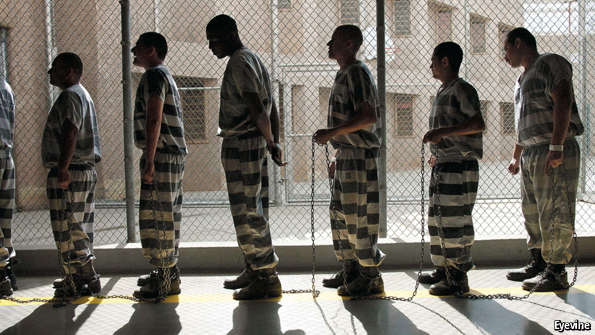by Biodun Iginla, The Economist Intelligence Unit. Research by Rochelle van Amber in New York.
Jailhouse nation
How to make America’s penal system less punitive and more effective

Bars and stripes
Advocates of tough justice point out that America’s crime rate has
fallen as the incarceration rate has risen. Criminals who are locked up
cannot mug law-abiding citizens, and the prospect of going to prison
must surely deter some from breaking the law in the first place. All
this is true, but only up to a point. In the 1980s expanding prisons
probably did help slow the rise of crime by taking thugs off the
streets. But mass incarceration has long since become counter-productive
(see article).
A recent study by the Brennan Centre for Justice, a think-tank,
concluded that at most only 12% of the reduction in America’s property
crime rates since the 1990s can be attributed to higher rates of
imprisonment—and that there might be no effect at all. States with
larger prison populations have no less crime than states with smaller
ones.More and more Americans accept that the harm caused by mass imprisonment now exceeds its benefits. Hillary Clinton, whose husband’s 1994 crime bill filled many a cell, has now changed her mind. On the right, fiscal conservatives decry the burden on taxpayers, while Christians talk of mercy. Rick Perry, a former governor of Texas and a Republican presidential candidate, boasts of his record of closing three prisons in his state. Nationwide, the incarcerated population appears to have plateaued; it should be sharply reduced.
A good start would be to end the war on drugs, which would do less harm if they were taxed, regulated and sold in shops, not alleys, as marijuana is in Colorado and Washington state. In fact, the drug war is already ebbing: in 1997 drug offenders were 27% of all prisoners; now they are around 20%. That could be cut to zero if drugs were legalised.
The next step would be to amend or repeal rules that prevent judges from judging each case on its merits, such as state and federal “mandatory minimum” sentences and “three strikes” rules that compel courts to lock up even relatively minor repeat offenders for most of their lives. New York has dramatically reduced its state-prison population this way. Prosecutors there have in effect been told to limit the number of people they imprison, giving them an incentive to lock up only the most dangerous. Prosecutors have long had huge discretion in which charges they bring; those in New York now use police intelligence to help them decide. If the man in the dock seems relatively harmless, they go easy on him; if they know him to be a career criminal who has remained free because he intimidates witnesses, they throw the book at him. Crime has fallen in New York. There has been no backlash among voters.
Reducing the prison population to European levels is probably impossible, for America is still a much more violent place, even if most districts are reasonably safe. There are roughly 165,000 murderers in American state prisons and 160,000 rapists. If America were to release every single prisoner who has not been convicted of killing or raping someone, its incarceration rate would still be higher than Germany’s.
But still, America does not need to lock up every violent criminal for as long as it does—which is longer than any other rich country. Some 49,000 Americans are serving life without the possibility of ever being released. (In England and Wales the number is just 55.) Such harshness is unnecessary. A 50-year sentence does not deter five times as much as a ten-year sentence (though it does cost over five times as much). Money wasted on long sentences cannot be spent on catching criminals in the first place, which is a more effective deterrent.
Reform is hard. Prosecutors and judges are often elected in America; many woo votes by promising to be tougher than their predecessors. Politicians who are seen to be soft on crime run a risk. One reason Michael Dukakis was never president was that a murderer called Willie Horton, who was released on furlough while Mr Dukakis was governor of Massachusetts, took the opportunity to rape someone.
Swift and sure justice, but less harsh
Nonetheless, the big fall in crime in the past two decades means that
Americans are now less afraid than they were, and more open to reform.
Californians voted last year in a referendum to downgrade several
non-violent felonies to mis-demeanours. Other states are experimenting
with better education in prisons (so that ex-convicts have a better
chance of finding work), and drug treatment or GPS-enabled ankle
bracelets as alternatives to incarceration. Some are also trying to
improve prison conditions, not least by curbing assaults and rapes
behind bars. The aim of penal policy should be harm reduction, not
revenge. Tighter gun laws might help, because guns can turn drunken
quarrels into murders; alas, that is politically improbable for now.
There is no single fix for America’s prisons, but there are 2.3m reasons
to try.
No comments:
Post a Comment